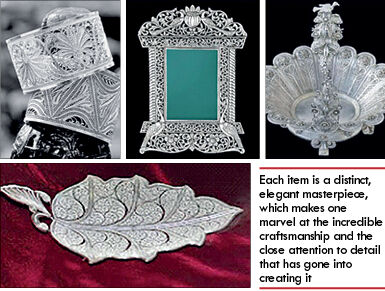Wired into a marvel
Originated in Elegandal and identified with Karimnagar, the elegant Silver Filigree, while remaining true to its original style, has managed to keep pace with the changing patterns of demand

Though the GI for Silver Filigree work is identified with Karimnagar, a district town about 160 km from Hyderabad, the origin of the craft can be traced to the hamlet of Elegandal, where it was introduced two centuries ago by an itinerant goldsmith named Kadarla Ramayya, a native of Yalagandala, who learned and absorbed this filigree jewel technique and craft. In Telugu parlance, filigree is called as, vendi teega pani (work done with silver wire). However, in 1905, this unique art form moved to Karimnagar, and it is here that dedicated artisans still practice the art as a legacy handed down across generations. Even after the advent of modern technologies and machineries, their style of working remains much the same as it has been since anyone can remember. Karimnagar, which derives its name from Syed Karimuddin, a Quiladar, is home to many tribes such as Gonds, Koyas, Chenchus — all living in their own settlements and speaking their own dialects but now expert and skilled in this craft.
The art form was patronised during the rule of the Nizams of Hyderabad, and noblemen commissioned elaborate pieces. Some of the masterpieces are displayed in the Salar Jung Museum. As the Chief Minister of Andhra and later the PM of India, Narasimha Rao, also belonged to this district, Karimnagar filigree was presented to state guests and visiting foreign dignitaries. Your columnist too received a replica of the Char Minar when he called on the then Governor of Andhra Pradesh, the late ND Tiwari, way back in 2009.
In 2007, Karimnagar Silver Filigree received Intellectual Property Rights protection, or Geographical Indication, when an application was filed by the Karimnagar Silver Filigree Handicrafts Mutually Aided Cooperative Welfare Society Limited in respect to handicrafts such as – key chains, bangles, bracelets, purses, hand bags, mirrors, brooches, arm bands, ear rings, ear tops, coat pins, chains, tie pins, buttons, paan-daan, attar-daan, cigarette boxes, cutlery ornamental boxes, kum-kum boxes, perfume tins, leaf-patterned purses, tea trays, monumental replicas like Charminar, high-tech city besides decoratives for Christmas trees and idols of gods and goddesses. This shows that the craftsmen have kept pace with the changing pattern of demand. Of course, the government of Telangana has now started offering special training to those involved in the craft to make the designs more contemporary, and also assists in the packaging and marketing of the products through state emporia as well as on web-based platforms.
The very delicate form of metal handicraft, mainly in the form of jewellery or statues, is made of pure silver and carries different weights. It is true that gold can also be used as a medium, but then the pricing would make it unaffordable; these gold-based filigree designs are made on a pre-order basis only. The average weight of a silver filigree art ranges from 100 grams to 3 to 4 kg. As the Nizam and his nobility were Muslim, human figures were out of sync, and the artistic expressions were usually geometric patterns, besides motifs of bird and flowers.
The process starts with the melting of silver by a method called 'Bhatti', which has been practiced for generations, followed by the use of 'a wire drawing machine' to produce very fine hair like wires. When two thin wires are heated and wound around a 'Charkha' and flattened again, the articles get the trellis-like appearance of 'jali' (net), so as to endow the article with a rare charm. This is followed by twisting of silver wire into zigzag patterns around the ribs of the design formed by thicker. The design setting is mostly done by women who give it the best form before it is heated again to give the requisite toughness to the entire structure and is polished to perfection.
The three types of work include 'meenakari', 'khulla-jaal' and 'phool-booti'. An article depicted in one type of work can be prepared in other types as well. What makes Silver Filigree so unique and delightful to the discerning eye is the fact that no two works of art are ever the same. Each item is a distinct, elegant masterpiece, which makes one marvel at the incredible craftsmanship and the close attention to detail that has gone into creating it. Needless to say, it involves extremely intricate techniques that require great patience and skill. The craft is delicate and time-consuming, consisting of cutting, twisting, plating of fine pliable wires or threads of silver or gold and uniting them at their points of contact with a base. The small grains or beads of the same metal, on the cross-junctions at regular intervals make it more efficient. The key uniqueness lies in the intricacy of the silver metal being made into thin wire, which is later twisted to give diverse designs.
So, when you plan a trip to Hyderabad, do not forget to carry back this unique souvenir.
Views expressed are personal



